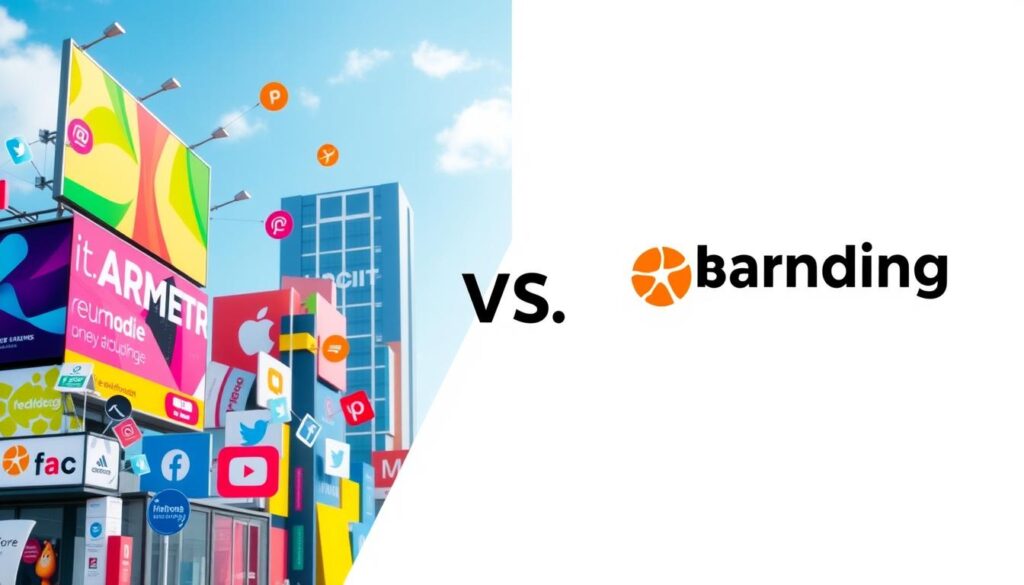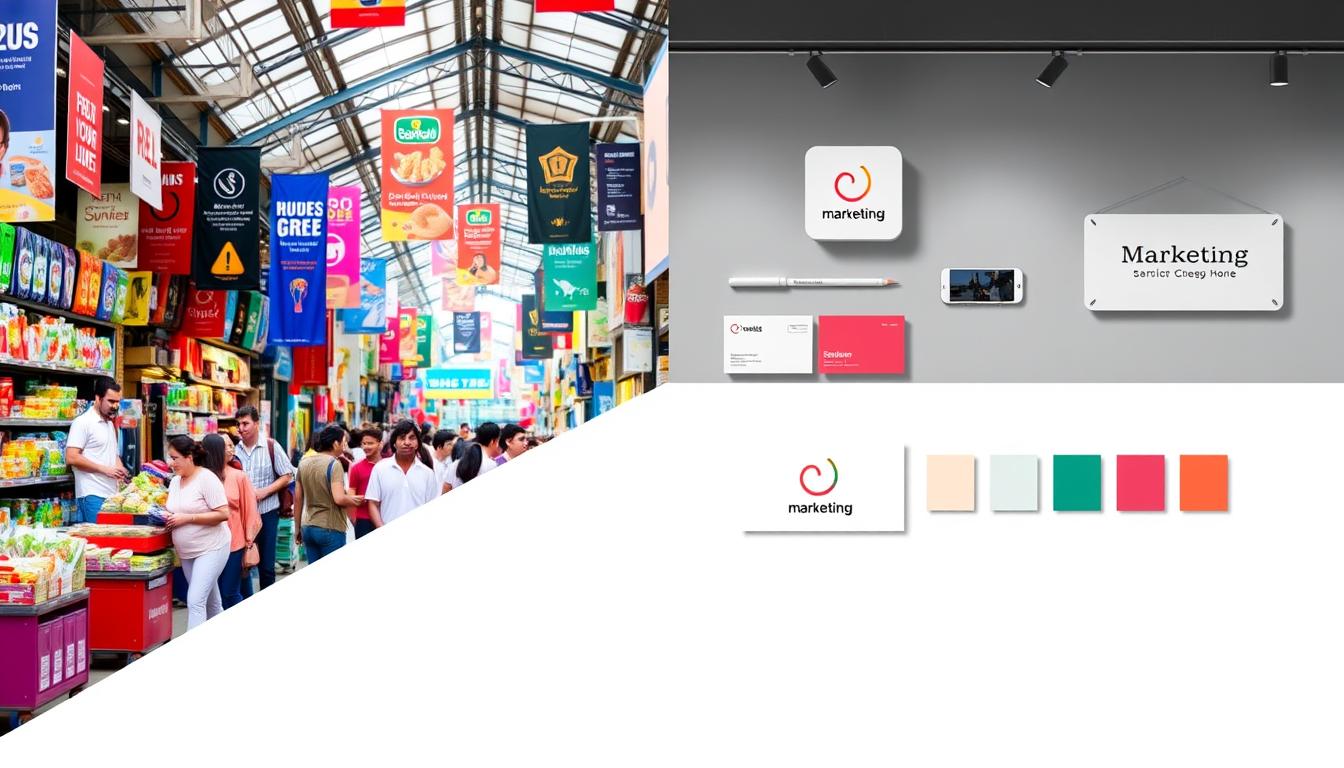In the fast-paced world of business, companies don’t just sell products. They sell branding, experiences, feelings, and ideas. A brand is a company’s unique identity and story. It sets them apart from others, aiming to become the top choice in the minds of their audience.
Branding is the strategy to create this unique identity. It involves making materials that support the brand and ensuring it’s present everywhere the company meets consumers. Brands like Coca-Cola aim to give customers a specific experience when they buy, showcasing the power of branding.
Key Takeaways
- Branding establishes a company’s unique identity and positioning in the market, while marketing focuses on promoting products and services to the target audience.
- Effective branding creates a strong emotional connection with customers, leading to increased brand loyalty and willingness to pay premium prices.
- A well-executed marketing strategy relies on a solid branding foundation to deliver consistent and impactful messaging across all customer touchpoints.
- Integrating branding and marketing efforts is crucial for small businesses, startups, and large enterprises to stand out in a competitive landscape.
- Brands with a clear, distinctive identity tend to enjoy higher success rates and better customer engagement compared to companies that solely focus on marketing tactics.
Marketing vs. Branding: Understanding the Key Differences
Marketing and branding are two important areas in business. Marketing focuses on promoting products or services to increase sales. On the other hand, branding aims to create a unique identity for a company. It’s about building loyalty and recognition over time.
A strong brand is the base for good marketing. It ensures the company’s message and values are clear everywhere. Branding is a long-term effort, while marketing is more focused on quick sales.
Business strategy, brand strategy, and marketing strategy all play a role in success. The business strategy sets the direction. Brand strategy enhances the brand’s essence. And marketing strategy makes sure the right product is offered at the right time.
| Marketing | Branding |
|---|---|
| Focuses on promoting products/services and driving sales | Focuses on creating a unique identity and story for a company |
| Utilizes tactics like advertising, promotions, and public relations | Encompasses elements like logos, brand personality, and brand positioning |
| Aims to attract and convert new customers | Aims to build long-term customer loyalty and recognition |
| Typically short-term in nature | A long-term, strategic investment |
In the end, marketing and branding are both crucial for success. A solid brand identity is key for effective marketing. Marketing efforts then help spread the brand’s message and position in the market.
“Branding is what people say about you when you’re not in the room.” – Jeff Bezos, Founder of Amazon
Defining Branding
Branding is about making a company or product stand out. It’s more than just marketing or ads. It’s about creating a brand that people remember and connect with. Key parts of branding include your brand identity, brand story, brand values, brand personality, and brand tone of voice.
What is a Brand?
A brand is what makes a company unique. It’s the mix of visuals, messages, and experiences that shape how people see your business. A strong brand can influence how people buy and choose your products.
Key Components of Branding
Good branding means focusing on a few key areas:
- Brand Identity: Your brand’s look, like logos, colors, and fonts.
- Brand Story: The story of your brand’s history, purpose, and what makes it special.
- Brand Values: The beliefs and principles that guide your brand’s actions.
- Brand Personality: The human-like traits that show your brand’s personality and attitude.
- Brand Tone of Voice: How your brand talks to its audience, consistently and uniquely.
By working on these elements, businesses can build a strong brand. This brand can earn trust, loyalty, and preference from customers.
The Role of Branding
Branding is key for businesses. It gives them a unique identity and makes them stand out. It also influences what people buy and supports marketing efforts. Plus, it makes employees proud to work there.
A strong brand image can make people think of quality or a certain lifestyle. This shapes how they see the product or service.
Branding helps people remember your business. It makes ads and marketing work better. It also boosts employee pride and support.
Branding is the base of a company’s marketing and communication plans. It builds loyalty, equity, and recognition. These are vital for growing and succeeding in the long run.
| Key Benefits of Branding | Importance |
|---|---|
| Brand Identity | Gives the business a unique and memorable persona that sets it apart from competitors. |
| Brand Loyalty | Encourages customers to repeatedly choose the brand over others, leading to sustained revenue. |
| Brand Equity | Enhances the perceived value of the brand, allowing it to command premium pricing. |
| Brand Recognition | Helps the brand become top-of-mind for customers, increasing the likelihood of purchase. |
The importance of branding is huge. It creates a unique identity for a business. It builds customer loyalty and supports marketing efforts. By focusing on branding, companies can lay a strong foundation for success and growth.
Defining Marketing
Marketing is more than just selling products or services. It’s about understanding your audience, knowing what they want, and finding ways to connect with them. Marketing is about finding and engaging buyers with the right product, price, place, and promotion.
What is Marketing?
Marketing is about promoting and selling products or services to potential customers. It includes many activities like market research, understanding your audience, and creating promotions. The main goal is to make people aware of your product, create demand, and increase sales.
Components of a Marketing Strategy
A good marketing strategy has several key parts:
- Market Research: Learning about the market, what customers like, and new trends through research.
- Target Audience: Finding out who you want to sell to and connect with.
- Unique Selling Proposition (USP): Showing what makes your product or service special compared to others.
- Marketing Tactics: Using different ways to promote, like content, social media, emails, and in-store promotions.
- Performance Tracking: Measuring how well your marketing works and using that info to improve.
By combining these parts into a solid strategy, businesses can promote their products well, build brand awareness, and increase sales effectively and affordably.
The Importance of Marketing
Effective marketing strategies are key for brand awareness and customer engagement. They help move buyers towards making a purchase. Being on the right channels, like social media, boosts marketing results.
Studies show 49% of people are influenced by ads. This makes digital advertising crucial for reaching buyers. Marketing involves understanding the target audience and their needs. It also means creating products that meet those needs.
Pricing and distribution are important in marketing. They set the product’s value and availability. Promotion helps share the product’s benefits with the audience.
“Nike’s slogan ‘Just do it,’ introduced in 1988, has become an iconic mantra for motivation and determination, illustrating the power of emotional branding.”
Brand marketing aims to promote and create awareness around a brand. It builds reputation and loyalty. Consistent marketing strengthens brand recognition and trust.
A unique brand identity makes a business stand out. It creates emotional connections with customers. Marketing focuses on the experience and feeling, not just products.
Strong brand recognition helps expand into new markets. Market research and tools like SurveySparrow are vital for successful strategies.
Key Differences Between Marketing and Branding
Marketing and branding are closely linked but have different goals and focuses. Knowing the main differences helps businesses use them well to meet their strategic goals.
Goals and Objectives
Branding aims to create lasting positive feelings towards a brand. It builds a strong, recognizable brand identity that connects with the audience and builds loyalty. Marketing, however, focuses on increasing awareness, driving sales, and boosting engagement with products or services.
Scope and Focus
Branding is a strategic effort that focuses on a business’s core identity. It includes brand purpose, values, personality, and visual identity. Marketing, on the other hand, is tactical and centered on promoting and selling specific products or services. It involves activities like advertising, public relations, and social media campaigns.
For example, Apple is known for its strong branding with a recognizable logo and high-quality products. The Coca-Cola’s “Share a Coke” campaign, which put names on bottles, was a hit in marketing, creating buzz on social media.
Successful companies do well in both marketing and branding to attract loyal customers and increase sales. By understanding these differences, businesses can create better strategies to reach their goals.

The Interrelationship Between Marketing and Branding
Branding, marketing strategy, and business strategy are key and connected. Business strategy sets the base, brand strategy boosts the brand, and marketing strategy brings it to life with promotions. Knowing the market, customers, and trends is vital for all.
Branding is the foundation for marketing. Marketing efforts should strengthen the brand’s image. These plans must work together, starting with business strategy, then brand strategy, and finally marketing strategy.
Take Apple as an example. It’s the world’s most valuable brand, worth $241 billion. Its branding, from the logo to product design, has driven its success. Apple’s marketing strategy, like targeted ads and product placements, has also boosted its brand image.
Airbnb has grown its brand strength by focusing on branding and marketing. On the other hand, Vlasic went bankrupt because it didn’t invest in branding and ads.
Combining branding and marketing well can bring big wins. It can cut marketing costs, increase leads and sales, and build strong brand equity and loyalty. This alignment gives businesses a lasting edge over competitors.
“Companies that invest in branding for the long term find their marketing costs reduced over time.”
Real-Life Examples of Effective Branding and Marketing
Branding and marketing work together to make a brand stand out. Let’s look at some examples that show how well they work together.
Budweiser, a famous American beer, brought back its “Whassup” ad with a COVID-19 twist. The new ad kept the brand’s fun and togetherness vibe. It connected with people during tough times.
Colgate, a top oral care brand, used sonic branding to improve its brand experience. They worked with sound experts to create happy, upbeat sounds. These sounds match Colgate’s mission to make smiles brighter.
| Brand | Branding Strategy | Marketing Example |
|---|---|---|
| Budweiser | Authentic, Fun, Camaraderie | “Whassup” Ad Campaign |
| Colgate | Sonic Branding, Oral Health, Wellness | Upbeat, Optimistic-Sounding Brand Notes |
These examples show how good branding can change how customers see a brand. They use creative marketing to make their brand memorable. By matching their brand personality and experience with marketing, these companies have built strong, recognizable brands.

Strategies for Integrating Branding and Marketing
To effectively integrate branding and marketing, businesses must adopt a strategic and holistic approach. By aligning these two crucial elements, companies can create a cohesive, impactful customer experience. This experience builds brand loyalty and drives business growth.
One key strategy is to conduct a thorough competitor analysis. Understanding the competitive landscape helps businesses differentiate their offerings. It also helps establish a unique brand persona. This analysis can uncover valuable insights that inform content planning and advertising strategies.
Defining a distinct brand persona is another essential strategy. Humanizing the brand and fostering an emotional connection with the target audience can significantly enhance brand recall and customer engagement. Regular refinement of the advertising content plan, based on data and audience feedback, ensures that marketing initiatives consistently reinforce and support the core brand identity.
- Strategic Alignment has shown to increase brand awareness by 25% and lead to a 30% increase in customer loyalty.
- Unified Messaging across all marketing channels has resulted in a 20% boost in sales conversion rates.
- Strategic Touchpoints that align branding and marketing efforts have led to a 35% rise in customer engagement.
- Adaptive Integration of branding and marketing strategies has been associated with a 15% increase in overall market share.
By aligning branding and marketing, businesses can create a cohesive customer experience. This experience resonates with the target audience and drives measurable results. This holistic approach to integrating branding and marketing is a powerful strategy for achieving long-term success and sustainable growth.
Conclusion
In the world of business, marketing and branding are key. They work together to help companies grow. Branding is about the company’s identity and story. It connects with customers on an emotional level. Marketing is about the plans to promote and sell what the brand offers.
When these two are in sync, businesses can offer a unified experience. This experience builds trust and loyalty. It also helps in making buying decisions and achieving long-term success.
Companies like Coca-Cola and Budweiser show how important it is to blend branding and marketing. They use these strategies to make their brand stand out and get results.
First, a strong brand strategy is needed. Then, marketing strategies should match the brand’s values. This way, branding and marketing work together well.
It’s also important to keep an eye on how well marketing is working. Both branding and marketing need to change and grow to stay effective.
In short, knowing the difference between marketing and branding is key for business success. By combining these, companies can make a lasting impression. This leads to growth and success in the long run.
“Effective branding enhances trust, evokes emotions, and increases the popularity of a brand, much like a positive response to a date invitation.”
Frequently Asked Questions
Let’s tackle some common questions about marketing and branding. These are key elements in business.
What is the difference between marketing and branding?
Marketing is about promoting products or services. It includes ads, sales, and PR. Branding creates a unique identity for a company. It focuses on values, personality, and looks.
Marketing aims for quick sales and awareness. Branding builds lasting connections with customers.
Why is branding important for a business?
Branding helps a business stand out. It builds a strong identity and loyalty. A good brand increases recognition and value.
It also attracts and keeps talent, forms good partnerships, and gets better prices.
How do marketing and branding work together?
Marketing and branding go hand in hand. Marketing activities like ads raise awareness. A strong brand guides the messaging and visuals of these campaigns.
This ensures a consistent brand experience. When they work together, businesses can make a strong market presence.
What are some examples of effective branding and marketing?
Brands like Apple and Nike have strong identities. They use creative marketing to connect with people. For example, Karcher saw an 81% increase in recognition with Outbrain.
Toyota got 40% more attention with Onyx by Outbrain™. These show how branding and marketing can lead to success.
How can a business integrate its branding and marketing efforts?
To blend branding and marketing, start with a clear brand strategy. This defines values, personality, and position. Then, use this strategy in all marketing.
Explore different marketing channels. Try native ads, YouTube, and local ads. This strengthens your brand and reaches more people.
FAQ
What is the difference between marketing and branding?
Marketing and branding are related but different. Branding is about a company’s identity and story. Marketing is how that story is told through tactics and strategies.
Branding comes first and marketing follows. Marketing should always support the brand’s message.
Why is branding important for a business?
Branding is crucial for a company. It gives the business an identity and makes it memorable. It also influences what people buy and supports marketing efforts.
A strong brand image can make a company seem high-quality or valuable. It shapes how people see the product or service.
How do marketing and branding work together?
Branding, marketing, and business strategy are all key. Business strategy sets the base, brand strategy amplifies the brand, and marketing strategy brings it to life.
Branding is the foundation for marketing. Marketing should always support the brand’s message.
What are some examples of effective branding and marketing?
Budweiser’s “Whassup” ad campaign is a great example. It updated its classic ad for COVID-19, showing the brand’s fun and authenticity.
Colgate used sonic branding to create upbeat sounds. These sounds reflect the brand’s focus on bright smiles.
How can a business integrate its branding and marketing efforts?
To blend branding and marketing, start with a competitor analysis. This helps understand the market.
Define a brand persona to make the brand relatable. Update your ad plan based on feedback and data. Always make sure marketing supports the brand’s core identity.
Resources:
Explore our curated list of recommended resources for printing, design, and free media assets. Whether you need professional printing services, free design templates, or royalty-free photos for your next project, these reliable sites have you covered.1. Printing & Design
- Printing Inc. Description: Singapore-based online printing service offering a variety of print products such as business cards, flyers, brochures, and custom stickers with professional design services.
- Namecards Inc. Description: Specialist in name card printing, providing a wide range of custom designs, finishes, and materials for high-quality business cards.
- Kian Hong Press Description: Established corporate printing company in Singapore, offering solutions for brochures, catalogs, annual reports, and other corporate stationery.
2. Free Design Templates
- Canva Description: Offers a wide range of free and customizable templates for various needs, including presentations, posters, social media, and marketing materials.
- FreePik Description: Provides thousands of free and premium templates for brochures, flyers, business cards, and more, along with editable vector illustrations and graphics.
- Piktochart Description: Focused on data visualization and professional templates for infographics, posters, presentations, and reports, with both free and premium options.
3. Free Royalty-Free Photos
- Pexels Description: Offers high-quality, free stock photos and videos shared by talented creators for commercial and personal use without attribution.
- Unsplash Description: A large collection of beautiful, high-resolution images contributed by photographers worldwide, available for free use in any project.
- Pixabay Description: A community-driven platform offering copyright-free photos, illustrations, and videos for use in any creative project, with no licensing restrictions.






